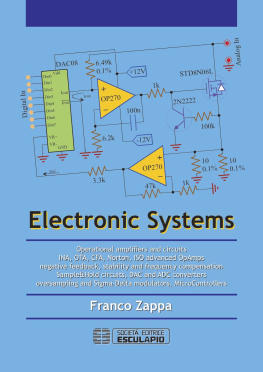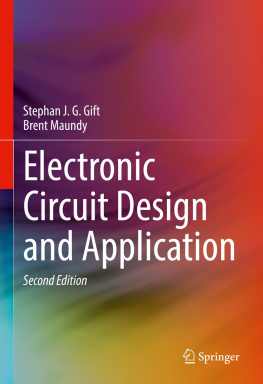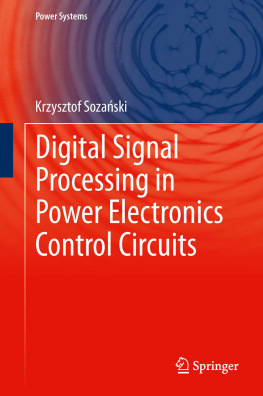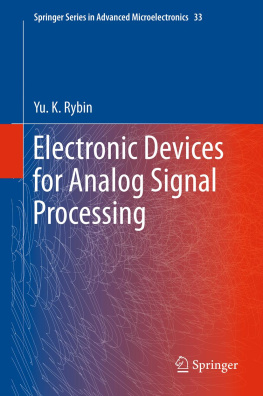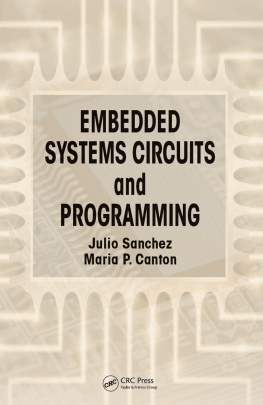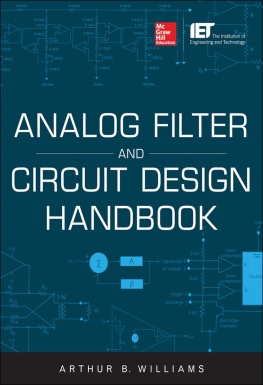Franco Zappa
Electronic Systems
Operational Amplifiers and circuits,
INA, OTA, CFA, Norton, ISO advanced OpAmps
negative feedback, stability and frequency compensation,
Sample&Hold circuits, DAC and ADC converters,
oversampling and Sigma-Delta modulators,
MicroControllers

Publishing Manager: Alessandro Parenti
Editorial Staff: Gabriella Gatti, Giancarla Panigali, Carlotta Lenzi
All rights reserved.
The reader can photocopy this publication for his personal purpose within the limit of 15% of the total pages and after the payment to SIAE of the amount foreseen in the art. 68, comma 4, L. 22 April 1941, n. 663, that includes the agreement reached among SIAE, AIE, SNS and CNA, CONFARTIGIANATO, CASA, CLAAI, confcommercio, confesercenti on December 18, 2000.
For purposes other than personal, this publication may be reproduced within the limit of 15% of the total pages with the prior and compulsory permission of AIDRO, via delle Erbe, n. 2, 20121 Milano, Telefax 02-80.95.06, e-mail:

40131 Bologna - Via U. Terracini 30 - Tel. 051-63.40.113 - Fax 051-63.41.136
www.editrice-esculapio.it
Edizione digitale: settembre 2014
ISBN: 9788874885510
Edizione digitale realizzata da Simplicissimus Book Farm srl
Summary
Index
A
acquisition time;
aliasing;
anti-aliasing filter;
amplifier
differential;
internally compensated/non-compensated;
operational;
output current;
real operational amplifier;
current mode;
data sheets;
voltage mode;
Analog to Digital Converter (ADC);
charge balancing;
charge redistribution;
commercial;
double ramp. V. Analog to Digital Converter (ADC) - double slope
double slope;
flash;
folding;
half-flash;
interpolating flash;
multistep flash;
non-idealities;
parallel pipelined;
pipeline;
quantization error;
serial pipelined;
sigma-delta;
single ramp. V. Analog to Digital Converter (ADC) - single ramp
single slope;
successive approximation (SAR);
tracking;
time interleaved;
B
bias current;
Bode stability criterion;
C
charge injection;
common mode rejection ratio (CMRR);
comparator;
dominant pole;
external;
feedforward;
input capacitance;
internal;
negative feedback;
output resistance and load capacitance;
pole-zero;
positive feedback;
two-pole;
current feedback amplifier (CFA);
structure;
current mode amplifier. see Norton
D
derivator
real;
dead zone;
differential amplifier;
Digital to Analog Converter (DAC);
dynamic parameters;
non-idealities;
output impedance;
precision;
voltage scaling;
weighted R;
digital potentiometer (dig-pot);
E
Effective Number of Bits (ENOB);
F
Fast Fourier Transform (FFT);
feedback
negative;
positive;
filter;
band pass;
Bessel;
Butterworth;
Cauer. V. elliptical filter
Chebyschev;
digital;
finite impulse response (FIR);
high pass;
infinite impulse response (IIR);
low pass;
universal active;
frequency response;
full power bandwidth (FPB);
G
gain
common mode;
differential;
loop;
Gilbert cell;
H
Harmonic Distortion;
I
idle channel. V. dead zone
impedance
input;
output;
instrumentation amplifier (INA);
integrator
ideal;
real;
inverting configuration
basics;
stability;
isolation amplifier (ISO);
M
multiplexer
analog;
non-idealities;
N
noise floor;
non-inverting configuration;
real gain;
Norton (current mode amplifier);
O
offset voltage;
oscillator;
astable multivibrator;
Collplits. V. three-points oscillator
Hartley. V. three-points oscillator
phase shift;
rectangular pulse generator;
three-points;
triangular signal generator;
Wien bridge;
oscilloscope
sampling;
over-sampling;
operational transconductance amplifier (OTA);
P
pattern noise;
peak detector;
pedestal error. V. charge injection
phase margin;
S
sample and hold;
errors;
feedback structures;
improved;
sampling
theorem;
Schmitt trigger;
inverting;
non-inverting;
settling time;
sigma-delta modulator;
commercial;
II order;
problems;
Signal to Noise Ratio (SNR);
Signal to Noise and Distortion Ratio (SiNAD);
slew rate;
stability;
subtractor;
T
U
under-sampling;
V
W
wave rectifier;
windowing;
Z
Acknowledgments
This book is the result of years of teaching in the Electronic Systems and Electronics courses at the Master in Electronic Engineering at Politecnico di Milano. Many grateful thanks to all PhD students who contributed to let this book become real.
This book deepens and complements concepts, components, and circuital stages introduced in the book Electronics, which provided the basics to analog and digital electronic component and electronic circuits design. Aim of this Electronic Systems book is to provide further advanced topics, integrated circuits and circuital configurations to students and engineers working in the many fields of design and development of electronic products and systems.
This is the first release in English of the book. Many grammar errors are still to be corrected and the quality of the English text will be further improved, for sure. I wish to apologize for such an inconvenience. However I preferred to deploy a text book as soon as possible to help students in the Master in Electronic Engineering.
My best appreciations to some of my PhD students, namely Simone Bellisai, Andrea Bahgat Shehata and Bojan Markovich, for the reviews, the translations, the lunches together and the nice atmosphere in the labs. My best gratitude to Hazar Yuksel, for a comprehensive revision of most chapters and an in-depth improvement of its fluency. Eventually my devoted gratitude to enthusiastic and charming Federica Villa, whose support did, does and will keep me teaching while smiling and the other way round, too.
Milano, October 2012.


Operational Amplifiers
Everybody screamed when I kissed the teacher
and they must have thought they dreamed when I kissed the teacher
All my friends at school
they had never seen the teacher blush, he looked like a fool
Nearly petrified cos he was taken by surprise
When I kissed the teacher
Couldnt quite believe his eyes, when I kissed the teacher
My whole class went wild
As I held my breath, the world stood still, but then he just smiled
Next page
